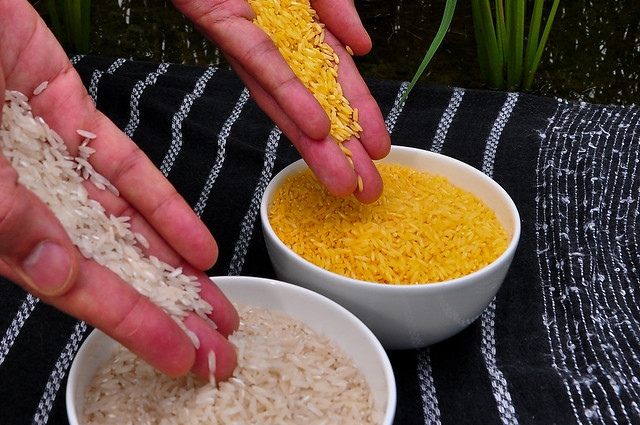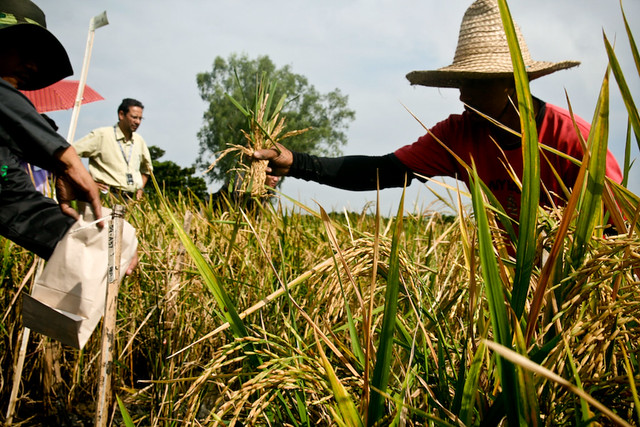Have you heard of golden rice? It’s possibly the genetically modified product with the most controversy around it – a hard title to snag – because of its goal: to eradicate malnutrition in some of the world’s poorest societies.

Image by IRRI, via Flickr Creative Commons.
Golden Rice is rice that has been genetically modified to biosynthesize beta carotine, a precursor to vitamin A – a vitamin that many people lack, especially in Asia and Africa. Vitamin A Deficiency is especially prevalent in children and pregnant women, with often dire consequences: An estimated 250,000 to 500,000 vitamin A-deficient children become blind every year due to this deficiency, half of them dying within 12 months of losing their sight. According to the World Health Organization, vitamin A deficiency can only be eradicated worldwide if both short-term nutritional supplements are distributed and in the long-term, vitamin A rich diets and food fortification is embraced.
This is where the Golden Rice comes in – it combines two favorable attributes in that rice is a staple food that is widely consumed, even in households with very low incomes. Secondly, it could provide the consumers with a natural source of vitamin A and thereby contribute to the eradication of that nutritional deficiency. Children are also often weaned on rice gruel, making rice an ideal vehicle to target their nutritional needs. An ingenious solution, right?
So why the controversy?
Because of its background goal linked to development cooperation, Golden Rice has often been seen as the “wunderkind” of genetically modified organisms and has been heralded as such by biotech companies. According to Neth Dano from the ETC group, the crop finally gives companies the opportunity to substantiate their claim that gen-tech is good for the poor, and effectively end a decade-long discussion. Thus, many ardent GMO opponents doubt whether the crop is more than a marketing ruse and would have any tangible benefits for the purported target group – children and mothers in developing countries.
This doubt in its effectiveness, in addition to the opposition by many environmentalists to the uncertain ecological risks associated with the introduction of a new species and potential crossbreeding, led to a rife debate on whether the GM crop should be approved for planting by governments – if its effects are below expectations, biotech companies would have still gained access to important markets where they could sell their products. In the Philippines, where researchers have undertaken the first field tests, the crop is currently still under consideration under the biosafety approval process.

Image by IRRI, via Flickr Creative Commons.
Speaking of the crop’s effects, there has also been great discord over whether it actually reaches its goal of remedying vitamin A deficiency. Two recent tests have found that the beta-carotine in the rice grains is easily absorbed by humans and that “a 100- to 150-gram bowl of Golden Rice should give children about 60 percent of the daily vitamin A they need.” On the other hand, it has not yet been proven that daily consumption of Golden Rice actually improves the vitamin A status of people who are vitamin A deficient in the long term and would therefore be suitable to reduce related conditions such as night blindness.
Furthermore, NGOs argue that there already exist local, low-cost, efficient nutrition programs which combat vitamin A deficiency, and where the money invested in the development and marketing of Golden Rice would have been better spent. They allege that the concerted push to bring the crop to market has been carried out without sufficient public consultation and risk assessment, and are suspicious of the underlying corporate interests.
On the other hand, the researchers behind the program express frustration with the bureaucratic hurdles they have to overcome to finally bring an idea to life that could improve the lives of millions of people. They also reject corporate involvement: “We have developed this in conjunction with organisations such as the Bill and Melinda Gates Foundation as a way of alleviating a real health problem in the developing world,” says Adrian Dubock, a member of the Golden Rice Project. “No one is going to make money out of it. The companies involved in developing some of the technologies have waived their licences just to get this off the ground.” (More on the licence waiving can be found here.)
What do you think? Is Golden Rice an ingenious idea to effectively combat malnutrition or a clever, if useful, marketing stint by biotech companies?
Bonus: For an interesting history of how golden rice went from brainchild to reality, head on over to the NPR story on the same issue. The International Rice Research Institute in the Philippines also has a transparent and informative blog about Golden Rice here. For an interesting dichotomy of opinions, I have two links for you: one from Foodwatch, an NGO which sees the issue very critically, and a Guardian article interviewing many of the researchers that collaborated on the project which hope for its speedy introduction.
As with any other GM food without undergoing trials over a long period of time, I have doubts. unfortunately, the linked article did not elaborate on the existing programs.
by the way, I came here from the coursera FB link 🙂
Hey Lim, thanks for commenting! Yeah it’s definitely a Catch-22 – according to the article the scientists had to overcome quite some administrative hurdles to even get it into the trial stage. Also, there was quite some uproar because there was this feeding study (where the nutrition information came from) with children from China that apparently hadn’t been told it was GM rice before they were given it…
Maybe I tend to be overly simplistic, but I’m pretty confident that this was not the only solution. One of my beefs with solutions from the Gates Foundation is that they are based upon modern first world systems that are not sustainable for third world farmers without ongoing help and expensive supply chain overhauls. It’s hard to imagine that there is not one single indigenous source of Vitamin A…
Good point. On the other hand, to play devil’s advocate, apparently they are intending to give away the rice (and the possibility to save seeds and regrow it) for free without strings attached – and if farmers are already farming rice they might not need that much technological assistance? Though the actual implementation mechanism is still rather unclear as of now, I guess.
As to indigenous sources of vitamin A, from what I understand that is what the WHO is currently supporting – the diversification of farms beyond just growing staple carbs, but the risk attached to that might be too large for farmers to take on, especially if their survival hinges on a successful harvest. Then again, nobody knows whether farmers would accept the foreign golden rice either, so there are still a lot of open questions, I guess…
They may be giving the rice, but can the farmers save seed and does it require non-traditional synthetic inputs? I thought about the acceptance too – people’s brains can really get stuck on things like that…
There are Orange-Fleshed Sweetpotatoes, promoted by Helen Keller International http://www.youtube.com/watch?v=wMLLbfq5V64 I’m gestating a blog post about this crop, including the question of whether it’s suitable for the same soils and climates that are suitable for rice.
Reblogged this on Science on the Land and commented:
argylesock says… Great article! Thanks for following my blog. I’ve written about Golden Rice too, and like you I’m open to persuasion. I notice that Helen Keller International promotes several responses to Vitamin A deficiency, with Golden Rice being only one possibility. Orange-fleshed sweetpotatoes (OFSP) are another promising line of research and development.
Thanks for your comment! Yes, I feel I haven’t really formed a definitive opinion yet, especially since it’s such a complex issue. And also touches on an interesting moral aspect – if companies are doing this to improve their reputation, but it’s still benefiting the target group, should we accept it or be opposed out of principle? In an ideal world I would love to see real public-private partnerships where you don’t have to have doubts and second thoughts about intentions, but how much do intentions matter as long as the outcome is positive (assuming that the intentions aren’t intrinsically linked to making the consumer worse off in the long run, e.g. if the golden rice needs specific high-priced inputs)..
Yes. I hope you’ll keep writing about this.
This is a great article. Love reading all your blog posts, because although I am no student of anything related to food (and its policies) I find the topic extremely interesting. Thanks for teaching me new things all the time. My outlook is definitely better for it.